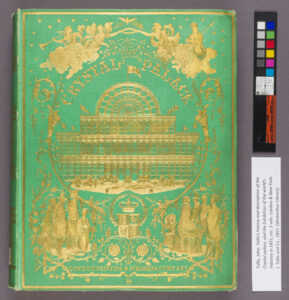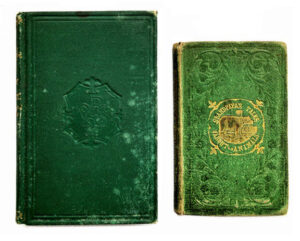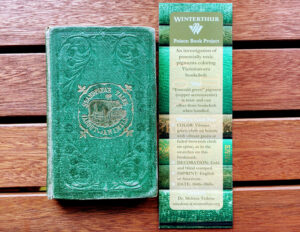The Poison Book Project
Cathy Koos
Not a poison pen book, but a poison book.
As a lover of old books, I am always drawn to second-hand bookstores, dusty boxes of vintage books at estate sales, and friend of the library sales. There is nothing quite to compare to the smell of an old bookstore. None of the fresh ink-and-paper scents of Barnes and Nobles. No, this is a fragrance unique to purveyors of old books. I am not sure if it is the ancient paper or ink or the microscopic bugs that inhabit the shelves of old tomes, but this is a distinct odor that I love.

Figure 1 Courtesy Winterthur Library
There can be hidden hazards, however, within the old cloth bindings, according to Melissa Tedone, a conservator at the Winterthur Library in Delaware. Especially be aware of covers in the minty emerald green color range of 19th century books. When asked to conserve an 1857 edition of Rustic Adornments for Homes of Taste, Tedone discovered bits of a green pigment readily flaking off the cover cloth. Microscopic inspection revealed the arsenic and copper compound of copper acetoarsenite.
Later found to be toxic, this arsenic pigment can be found not only in Victorian-era book cover, but in wallpapers, wearing apparel, and household goods. This emerald green pigment became wildly popular in the United States and England. With the formula being a closely guarded trade secret, research has been stymied by lack of available resources.

Figure 2 Baldwin Library, University of Florida
There is no safe handling procedure as with lead, so Winterthur has advised handling suspected arsenic textiles and books with nitrile gloves, under a ventilation hood. Avoid touching the face, biting fingernails, eating, or drinking while handling suspected textiles. The arsenic colorant is extremely friable, presenting a potential hazard to librarians and textile conservers.
Isolate suspected books or textiles in sealed zip-top bags and label. Consider relocating all suspected items and include in any disaster planning.
An ever-evolving database of books can be found here: http://wiki.winterthur.org/PoisonBookProject

Figure 3 Winterthur bookmark
Winterthur has developed a free bookmark to aid in identification of potentially arsenical book covers and textiles. To request yours, email to reference@winterthur.org and put “Emerald Green Bookmark” in the subject line.